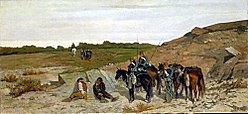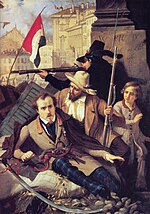Post-unification Italian brigandage
| Brigantaggio | |||||||
|---|---|---|---|---|---|---|---|
| Part of theItalian unification | |||||||
 An episode of brigandage in 1864 | |||||||
| |||||||
| Belligerents | |||||||
|
|
Southern Italian brigands Supported by: BourbonLegitimistsin Southern Italy Partisans fromBourbon Spain | ||||||
| Commanders and leaders | |||||||
|
Alfonso La Marmora Enrico Cialdini |
Carmine Crocco(POW) Ninco Nanco José Borjes | ||||||
| Casualties and losses | |||||||
|
(1861–1864)[1][2] 603 killed Including 21 officers 253 wounded 24 captured or missing |
(1861–1864)[1][2] 2,413 killed 2,768 captured 1,038 executed | ||||||
Brigandage inSouthern Italy(Italian:brigantaggio) had existed in some form since ancient times. However, its origins asoutlawstargeting random travellers would evolve vastly later on to become a form of a politicalresistance movement,especially from the 19th century onward. During the time of theNapoleonicconquest of theKingdom of Naples,the first signs of political resistancebrigandagecame to public light, as theBourbonloyalists of the country refused to accept the new Bonapartist rulers and actively fought against them until the Bourbon monarchy had been reinstated.[3]Some claim that the word brigandage is a euphemism for what was in fact acivil war.[4]
History[edit]

Following the upheaval duringSicily's transition out offeudalismin 1812, a lack of an effective police force made banditry a serious problem in much of rural Sicily during the 19th century.[5]Risingfood prices,the loss of public and church lands, and the loss of feudalcommon rightspushed many desperate peasants into banditry.[5][6]
With no police to call upon, local elites in countryside towns recruited young men into "companies-at-arms" to hunt down thieves and negotiate the return of stolen property in exchange for a pardon for the thieves and a fee from the victims - a development that is often seen as the genesis of theMafia.[7]These companies-at-arms were often made up of former bandits and criminals, usually the most skilled and violent of them.[6]While this saved communities the trouble of maintaining their own policemen, this may have made the companies-at-arms more inclined to collude with their former brethren rather than destroy them.[6]
After the fall of theHouse of Bourbon'sKingdom of Two Siciliesand its merger with theHouse of Savoy'sKingdom of Sardiniain 1861, which created theKingdom of Italy,the most famous form ofbrigandageemerged inSouthern Italy.[8]According toMarxisttheoretician Nicola Zitara, Southern Italy experienced social unrest, especially among the lower classes, due to poor conditions and the fact that theunification of Italyhad only benefited the land-owningbourgeoisie,[3]so many turned to brigandage in the mountains ofBasilicata,Campania,CalabriaandAbruzzo.However, the brigands were not a homogeneous group, nor did they operate with any common cause. The brigands consisted of a mixture of people with different backgrounds and motives. They included former prisoners; bandits and other people who the Italian government regarded as common criminals; former soldiers and loyalists from the former Bourbon army; foreign mercenaries in the pay of theBourbon king in exile;somenobility;poverty stricken farmers; and peasants who wantedland reforms.Both men and women took up arms.[3]
Brigands launched attacks, not just against the Italian authorities and the landowners, but also against common people,[9]frequently looting villages, towns and farms, and committing armed robberies against both individuals and groups, including farmers, townspeople and rival brigand bands.[9]Robberies by brigand bands were often accompanied by other acts of violence and vandalism, such as arsons, murders, rapes, kidnappings, extortions and crop burnings.[9]


An extremely harsh repression of the brigands by the Italian authorities began in 1863, especially after the passing of thePica Laws,which permitted the arrest of relatives and those suspected of collaborating or helping a brigand.[10]The villages ofPontelandolfoandCasalduniin theProvince of Beneventobecame the site of a massacre of thirteen brigands by ItalianBersaglieri,[11]as a reprisal after the massacre of forty-five soldiers of theItalian armyby local brigands.[12]In total, several thousand brigands were arrested andexecuted,while many more weredeportedor fled the country (seeItalian diaspora).[3]In Palermo in 1866, 40,000 Italian soldiers were needed to put downThe Seven and a Half Days Revolt.
An indication of the number of deaths during the conflict, including killings and other damages caused by brigandage, can be found in "Result of Operations", signed by colonel Bariola of the 6th Military Department inNaples,for the first nine months of 1863:[13]421 brigands had been killed in combat, 322 were shot by firing squad, 504 arrested and 250 surrendered. During the same period, the brigands killed 228 soldiers and wounded 94, killed 379 other persons and kidnapped 331, and killed or stole 1,821 head of cattle.
Whilst brigandage was virtually non-existent in the annexed states of northern and central Italy after the unification in 1861, such as theKingdom of Lombardy–Venetia,theDuchy of Parma,theDuchy of Modena,theGrand Duchy of Tuscanyand thePapal States,the situation in Southern Italy was very different, owing to the previous centuries of history. In his bookEroi e briganti(Heroes and brigands),[14]the Italian historian and politicianFrancesco Saverio Nittidescribes how brigandage was endemic in southern Italy already before 1860:
«…every part of Europe has had brigands and criminals who during wars and misfortune dominated the countryside and put themselves outside the law […] but there was only one country in Europe where brigandage has existed we can say always […] a country where brigandage for many centuries can look like a huge river of blood and hates […] a country where for centuries monarchy based itself on brigandage that became like a historical agent: this is the country of Midday »(from Italian “Mezzodì” or “Mezzogiorno”, the name for Southern Italy during the 19th century).
There is a thesis that the brigandage in southern Italy was a popular revolt againstItalian unificationand theHouse of Savoy,but it should noted that after 1865–1870 the brigandage movement was never followed by any anti-Savoy or anti-unification movement. Many southern Italians held high positions in the new Italian government, such as the 11th Prime Minister of ItalyFrancesco Crispi.Italians from southern Italy would also go on to play a key role in the ultra-nationalistFascist movement,most notably the so-called 'philosopher of Fascism'Giovanni Gentile.[citation needed]The thesis that southern Italy was hostile to Savoy after the unification also doesn't explain the fact that in the referendum on 2 June 1946, about the creation of theItalian Republic,the south voted overwhelmingly for the Savoy monarchy, while the north voted for a republic, and from 1946 to 1972 the monarchist parties (which merged into theItalian Democratic Party of Monarchist Unity) were especially strong in the south and in Naples (a city in which nearly 80% supported the Savoy monarchy).[15]
-
A small band of brigands fromBisaccia,photographed in 1862
-
The brigandCarmine Crocco
-
The brigandMichelina Di Cesare
-
The brigandGiuseppe Musolino.
Brigandage in Southern Italy would continue sporadically after the 1870s. Brigands such asGiuseppe MusolinoandFrancesco Paolo Varsallona,both operating at the turn of the 20th century, as well asSalvatore GiulianoandGaspare Pisciotta,operating inSicilyfrom the 1940s to 1950s, all formed bands of brigands in Southern Italy and gained significant status as localfolk heroes.Sardinian banditsand theAnonima sardaalso continued to practice forms of brigandage into the 20th century.
In popular culture[edit]
In 2024,Netflixwill release a series about Italian brigandage titledBrigands: The Quest for Gold.[16]
See also[edit]
References[edit]
- ^abMolfese, Franco (1966).Storia del brigantaggio dopo l'Unità.Milan.
{{cite book}}:CS1 maint: location missing publisher (link) - ^abMonatsschrift zum Conversations-Lexikon (1870).Unsere Zeit.Leipzig.
{{cite book}}:CS1 maint: location missing publisher (link) - ^abcd"Briganten in Süditalien (i briganti)".Mein-Italien.info. 16 April 2008.
- ^Finley, Moses I.; Smith, Denis Mack (1968-01-01).A History of Sicily: Modern Sicily, after 1713, by D.M. Smith. (B 68-13584).Chatto & Windus. p. 453.
- ^abJason Sardell,Economic Origins of the Mafia and Patronage System in Sicily,Worcester Polytechnic Institute, 2009.
- ^abcOriana Bandiera,Private States and the Enforcement of Property Rights: Theory and evidence on the origins of the Sicilian mafiaArchived2012-03-19 at theWayback Machine,London School of Economics and CEPR, 2001, pp. 8–10
- ^Lupo,History of the Mafia,p. 34
- ^Ilaria Porciani, "On the Uses and Abuses of Nationalism from Below: A Few Notes on Italy", inMaarten Van GinderachterandMarnix Beyen(eds.),Nationhood from Below: Europe in the Long Nineteenth Century(London: Palgrave Macmillan2012), p. 75: "the so-calledBrigantaggio(1860–1870) ".
- ^abcHilton Wheeler, David (1864).Brigandage in South Italy, by David Hilton Wheeler, Volume 2.London: Sampson Low, Son, and Marston. p. 294.
- ^"Legge Pica (1863)".Polyarchy.org. 16 April 2008.
- ^Desiderio, Giancristano (August 8, 2016)."Pontelandolfo, una lettera inedita del 1861: 'Perirono 13 persone'".sanniopress.it.
- ^Sergio Rizzo, Gian Antonio Stella."Il rogo delle case e 400 morti che nessuno vuole ricordare".www.corriere.it.
- ^I Carabinieri nella campagna contro il Brigantaggio
- ^Eroi e briganti(Heroes and brigands) by Francesco Saverio Nitti – (edition 1899) – Osanna Edizioni 2015 –ISBN8881674696,9788881674695 – page 33
- ^Of 1,145,624 valid votes, 903,651 (79%) were monarchist and 241,973 republican (21%)(See page 234 Istat data, in Franco Malnati,La grande frode. Come l'Italia fu fatta Repubblica,Bastogi Collana De Monarchica, Bari, 1998,
- ^Wiseman, Andreas (17 September 2021)."Netflix Reveals Italian Series Slate Including Elena Ferrante Drama; MGM's Pamela Abdy To Get Zurich Game Changer Award — Global Briefs".Deadline.
Further reading[edit]
- A. Maffei,Brigand Life in Italy: A History of Bourbonist Reactionca.1865.
- Lupo, Salvatore (2009).The History of the Mafia,New York: Columbia University Press,ISBN978-0-231-13134-6
- New York Times,Brigandage in the Two Sicilies.April 25, 1874.





